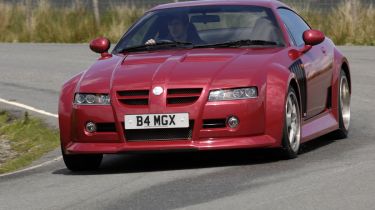MG X-Power SV-S
MG's doomed SV-R is supercharged and reborn as the everyday supercar.
From the cockpit, the SV-S seems almost too ordinary to be called a supercar. However, its incredible performance and sheer road presence cannot be questioned – the amount of attention it attracts from passers by is astonishing. The trouble is, its Rover-derived image may put off those able to afford it – which is a shame, as Riley and his team have turned the old SV-R into something quite special. It’s definitely worth a drive for supercar-with-a-difference thrills.
There have been better times to launch a supercar. In fact, there probably hasn’t been a worse time: fuel prices are sky rocketing, green issues grow stronger by the day and the credit crunch means even the most affluent are tightening their belts.
So what chance is there for a supercharged 520bhp MG costing £85,000? Better than you might imagine...
But to really answer the question, it’s important to understand exactly how the MG brand has arrived at this place.
To summarise, a handful of cars, badges and mechanical parts slipped through the net when Nanjing Automobile bought MG Rover in 2005, and they were acquired by a British enthusiast called William Riley.
One of those vehicles was this, the MG X Power SV-R, which MG Rover had conceived as its halo supercar – a flagship to revive the firm’s fortunes.
Used - available now

2021 Jaguar
XE
31,847 milesAutomaticPetrol2.0L
Cash £24,995
2023 Peugeot
3008
28,192 milesAutomaticDiesel1.5L
Cash £18,730
2023 Kia
Picanto
56,757 milesManualPetrol1.0L
Cash £8,800
2024 SEAT
Leon
31,169 milesManualPetrol1.5L
Cash £15,400While the original model was famously under-developed, with a scruffy interior and teeth-rattling ride at low speeds, Riley’s team has gone back to the drawing board to substantially improve things.
The result is a heavily reworked car that promises to answer the critics. Six a month will be built initially, spearheading a grand plan which also involves selling a soft-top, a fibreglass-bodied entry-level V6 and an electric version capable of 150mph and 0-60mph in five seconds.
First impressions aren’t great, as the exterior and cabin are the same as the old SV-R’s. There’s a fairly bland collection of parts, including Rover 75 components swathed in leather – although bespoke options are available. A raft of tweaks under the skin has transformed the driving experience, however. The main change is the addition of a supercharger to the hand-built Ford 5.0-litre V8 engine used in the original SV-R (hence the 'SV-S' moniker of the newcomer). The unit has also been remapped and the cam timing altered, taking power from 385bhp to 520bhp.
New springs and dampers mean the ride is more akin to a hot hatch than a ferocious rear-wheel-drive supercar, yet traction control and a limited slip-diff keep the power in check when rapid progress is being made.
While the retuned hydraulic power-steering is light at first, it stiffens with speed, and what it lacks in outright feel it more than compensates for with accuracy.
The SV-S has a relatively mild-mannered nature when cruising. But floor the throttle, and the supercharged V8 propels it from 0-60mph in 3.9 seconds, while the maker claims the maximum speed is in excess of 200mph.
The MG is calm and docile, and never feels intimidating to drive. On more challenging roads the chassis offers huge amounts of grip. Even so, the traction control cuts in early to cancel out the inevitable wheelspin when cornering hard in second gear.
There’s no doubt that the SV-S is capable, but at £85,000, it’s competing with big-hitting heavyweights such as Porsche, as well as established British sports car firms such as Noble and Morgan. And prospective buyers may be put off by the MG badge on the nose.
Rival: Morgan Aero 8
The Aero 8 mates a BMW V8 with old-school open-top appeal. Driving dynamics are superb, thanks to the well judged suspension and aluminium body. What’s more, it costs £20,000 less than the SV-S.



